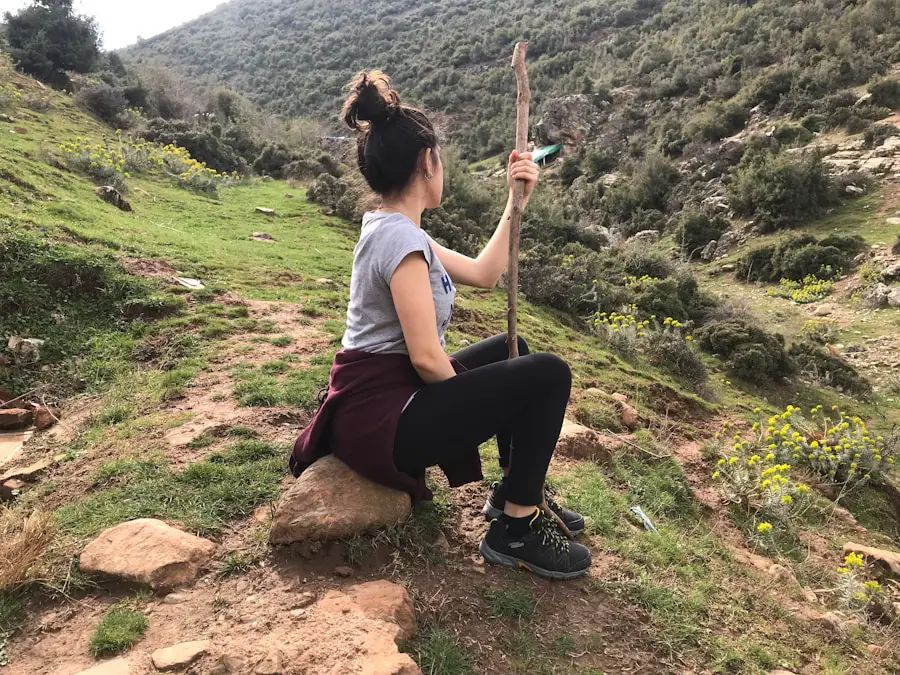Selecting the appropriate length for a hiking stick is a critical decision that can significantly impact your overall hiking experience. A hiking stick, or trekking pole, serves multiple purposes, including providing stability, reducing strain on joints, and enhancing balance on uneven terrain. When the length of the stick is well-suited to the hiker’s height and the specific conditions of the hike, it can lead to improved posture and a more efficient stride.
Conversely, an ill-fitting hiking stick can lead to discomfort and fatigue, detracting from the enjoyment of the outdoor adventure. The right hiking stick length can also influence your ability to navigate various terrains. For instance, when traversing steep inclines or declines, a properly sized stick can help maintain balance and reduce the risk of falls.
Additionally, using a hiking stick that is too long or too short can alter your natural gait, leading to inefficient movement and increased energy expenditure. Therefore, understanding the importance of selecting the right length is essential for both novice and experienced hikers alike.
Key Takeaways
- Choosing the right hiking stick length is important for comfort, stability, and injury prevention
- Factors to consider when selecting hiking stick length include your height, the type of terrain you’ll be hiking on, and personal preference
- To measure the correct hiking stick length, stand up straight with your arms at a 90-degree angle and adjust the stick to reach your wrist
- Using the correct hiking stick length can reduce fatigue, provide better balance, and alleviate pressure on your joints
- Using the wrong hiking stick length can lead to discomfort, instability, and potential injury on the trail
Factors to Consider When Selecting Hiking Stick Length
When determining the ideal length for a hiking stick, several factors come into play. One of the most significant considerations is the height of the hiker. Generally, a good rule of thumb is that when standing upright with your arms at your sides, the top of the hiking stick should reach your wrist bone.
This guideline provides a starting point for finding a stick that will offer optimal support and comfort during hikes. However, individual preferences and body proportions can vary widely, making it essential to consider personal comfort in conjunction with general recommendations. Another critical factor is the type of terrain you plan to hike.
For example, if you frequently hike in mountainous regions with steep ascents and descents, you may prefer a shorter stick that allows for better maneuverability and control. Conversely, if you often hike on flat or rolling terrain, a longer stick may provide additional reach and stability. Additionally, the weight of the hiker can influence the choice of stick length; heavier individuals may benefit from a sturdier, longer pole that can withstand greater force during use.
How to Measure the Correct Hiking Stick Length

Measuring for the correct hiking stick length involves a straightforward process that can be done at home or in-store. To begin, stand up straight with your shoes on and your arms relaxed at your sides. Bend your elbows at a 90-degree angle and measure from the ground to your wrist bone.
This measurement will give you a baseline for selecting a hiking stick length that suits your body mechanics. Many trekking poles come with adjustable lengths, which can be beneficial for those who may want to adapt their poles for different types of hikes or varying terrains. In addition to measuring while standing still, it can be helpful to simulate hiking conditions by bending slightly at the knees and adopting a more dynamic stance.
This adjustment accounts for how your body will move while using the stick on an actual hike. If possible, try out different lengths in-store or during a test hike to see how they feel in action. The goal is to find a length that allows for comfortable arm positioning while maintaining an efficient stride.
Benefits of Using the Correct Hiking Stick Length
| Benefits | Details |
|---|---|
| Reduced Joint Strain | Using the correct hiking stick length can reduce strain on your knees, hips, and ankles by providing additional support and stability. |
| Improved Balance | A properly sized hiking stick can help improve your balance, especially on uneven terrain, reducing the risk of falls and injuries. |
| Increased Endurance | By distributing some of your body weight to the hiking stick, you can conserve energy and increase your endurance during long hikes. |
| Enhanced Posture | The right hiking stick length can promote better posture, reducing strain on your back and shoulders and preventing muscle fatigue. |
| Improved Speed | With the help of properly sized hiking sticks, you can increase your speed and efficiency while hiking, especially when going uphill or downhill. |
Using a hiking stick that is appropriately sized offers numerous benefits that enhance both safety and enjoyment during outdoor excursions. One of the primary advantages is improved stability. A correctly sized stick provides additional points of contact with the ground, which can help distribute weight more evenly and reduce the risk of slipping or falling on uneven surfaces.
This stability is particularly valuable when navigating rocky trails or crossing streams where footing may be uncertain. Moreover, using the right length can alleviate strain on joints, particularly in the knees and hips. When hiking downhill, a longer stick can help absorb some of the impact that would otherwise be absorbed by your legs.
This reduction in strain can lead to less fatigue over long distances and allow hikers to enjoy their journey without discomfort. Additionally, proper stick length encourages better posture by promoting an upright stance, which can enhance breathing efficiency and overall endurance during hikes.
Consequences of Using the Wrong Hiking Stick Length
The repercussions of using an incorrectly sized hiking stick can be significant and detrimental to both performance and safety. A hiking stick that is too long may force the hiker into an awkward posture, leading to back pain or discomfort in the shoulders and arms. This misalignment can also result in inefficient energy use, causing fatigue to set in more quickly than it would with a properly sized pole.
Hikers may find themselves compensating for this discomfort by altering their gait, which can lead to further issues such as blisters or joint pain. On the other hand, a hiking stick that is too short can limit reach and stability, making it difficult to navigate challenging terrain effectively. Hikers may struggle to maintain balance on steep inclines or declines, increasing their risk of falls or injuries.
Additionally, using a short pole may not provide adequate support when traversing uneven ground or carrying heavy loads, ultimately detracting from the overall hiking experience. The consequences of choosing an inappropriate length extend beyond mere discomfort; they can impact safety and enjoyment in profound ways.
Adjusting Hiking Stick Length for Different Terrains

One of the advantages of modern hiking sticks is their adjustable length feature, which allows hikers to tailor their poles according to varying terrains encountered during their adventures. For instance, when ascending steep hills, shortening the pole can help maintain an upright posture and provide better leverage against gravity. Conversely, when descending steep slopes, extending the pole can offer additional support and stability as it helps absorb some of the downward force exerted on the legs.
In addition to elevation changes, different types of terrain may also necessitate adjustments in pole length. On flat trails or well-maintained paths, hikers might prefer a longer setting for increased reach and comfort during long strides. In contrast, when navigating rocky or uneven surfaces where precision is key, a shorter pole may provide better control and maneuverability.
Understanding how to adjust pole length based on terrain not only enhances safety but also contributes to a more enjoyable hiking experience.
Tips for Testing Hiking Stick Length Before Purchase
Before committing to a specific hiking stick length, it’s wise to test various options to ensure you find one that feels comfortable and effective for your needs. If shopping in-store, take advantage of any available testing areas where you can walk around with different poles. Pay attention to how each length feels as you simulate various movements associated with hiking—such as ascending or descending slopes—and assess whether you feel stable and balanced.
If you are purchasing online, consider looking for retailers that offer easy return policies so you can try out different lengths at home without risk. When testing at home, replicate conditions similar to those you would encounter on actual hikes by walking on uneven surfaces or inclines if possible. Additionally, consider bringing along any gear you typically carry while hiking; this will help you gauge how well the pole supports you under realistic conditions.
Finding the Perfect Hiking Stick Length for You
Finding the perfect hiking stick length is an essential aspect of preparing for any outdoor adventure. By considering factors such as height, terrain type, and personal comfort preferences, hikers can select poles that enhance their experience rather than detract from it. Measuring correctly and testing various lengths ensures that you choose a stick that provides optimal support and stability while minimizing strain on your body.
Ultimately, investing time in selecting the right hiking stick length pays dividends in terms of safety and enjoyment on the trail. Whether you’re embarking on a leisurely day hike or tackling challenging backcountry routes, having a properly sized hiking stick can make all the difference in how you experience nature’s beauty.
When determining how tall a hiking stick should be, it is important to consider factors such as your height and the type of terrain you will be hiking on. For more tips on choosing the right hiking gear, check out this article on the best carry-on luggage for international travel. This article provides valuable insights on selecting the most suitable gear for your outdoor adventures.
Love travel? Join Our Facebook Community For More Tips.
FAQs
What is the ideal height for a hiking stick?
The ideal height for a hiking stick is generally considered to be around hip height when standing on flat ground.
How do I determine the right height for my hiking stick?
To determine the right height for your hiking stick, stand up straight with your arms at your sides. The top of the hiking stick should reach your wrist when your arm is bent at a 90-degree angle.
Can the ideal height for a hiking stick vary for different people?
Yes, the ideal height for a hiking stick can vary depending on a person’s height and personal preference. It’s important to adjust the hiking stick to a comfortable height for each individual.
What are the benefits of using a hiking stick at the right height?
Using a hiking stick at the right height can help improve balance, reduce strain on the knees and joints, and provide additional support while hiking on uneven terrain.
Are there adjustable hiking sticks available for different heights?
Yes, there are adjustable hiking sticks available that can be easily customized to fit the height of the individual user. These can be a convenient option for hikers of varying heights.
